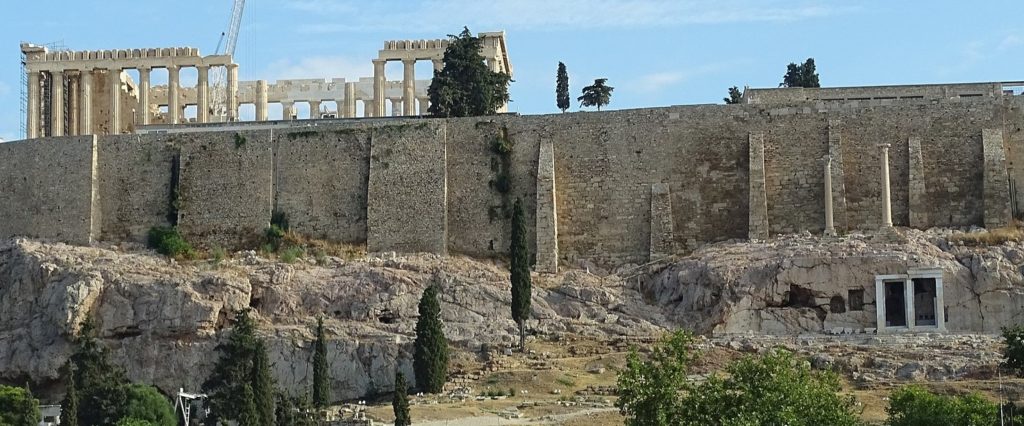
The Acropolis of Athens naturally sends eyes skyward, to take in the glories of the Parthenon and other buildings atop it — but its best kept secret is a chamber inside the sacred rock.
The secret chamber of the Acropolis is actually a Byzantine church. Restored in 2017, the one-time place of worship burrows deep into the base of Athens’ most renowned mountain. Above the Dionysus Theater is the church called Panagia Spilotissa, or the Virgin Mary of the Cave, which was converted from an archaic temple.
Ironically, the church originated as a temple to celebrate the ancient Greek god of festivity and religious madness. Dating back to 320 BC, the cave was a temple dedicated to Dionysus, built by Thrasyllos. Two Ionian pillars still stand on top of the entryway, easily spotted from the pedestrian walkway, the Dionysios Areopagitis, that borders the Acropolis.
Acropolis’ Secret: First an Archaic Monument, Then an Alternative Church
The monument was erected to celebrate Thrasyllos’ victory as the benefactor of a chorus that performed in the annual dramatic festival that honored Dionysus. After the victory, Thrasyllos had the monument constructed. It was again modified in 297 BC, following his son, Thrasyklis, victory to include inscriptions.
On the rocks nearby are inscriptions that have led many to believe that there were also other monuments situated there at one time.
The monument was built around a natural hollow in the rock and cut away to form a cave 20 feet deep and 20 feet high. It is situated just below the south wall of the Acropolis and has access from above the Theater of Dionysus.
The cave was most likely considered sacred long before the construction of the monument. It may have been dedicated to Artemis, the goddess of the hunt. The rock face was cut back to form a flat vertical surface, and the mouth of the cave was enlarged into a rectangular opening. Two broad stone steps led up to the entry.
A Doric marble portico was set at the front of the cave, in imitation of the Propylaea, on the southwest wing of the Acropolis. The structure would have been surmounted with three bronze tripods that served as the actual prizes in the annual competition that involved drama, comedy, and musical performances.
The tripods were eventually replaced with a statue of Dionysus.
Tragically, this too, fell victim to the pillage of the British Ambassador to the Ottoman Empire, Lord Elgin, in 1802 — as did so many of the statues on the Parthenon’s frieze. The statue is on display — as are the frieze statues — in the British Museum. The Thrasyllos monument was, however, preserved until 1827. It sadly collapsed following the bombardment during the Ottoman siege of the Athens.
Best-Preserved Examples of post-Byzantine Hagiography
“The fresco decoration of Panagia Spiliotissa comprises the best preserved examples of post-Byzantine hagiography in the area of the Acropolis and its slopes,” according to Dr. Konstantinos Boletis. Boletis serves as an Architect-Restorer for the Department/Ephorate of Antiquities of the City of Athens.
The church was one of the “alternative” places to worship that began to emerge in Athens during the sixth century, following the decrees sent down by the Byzantine Emperors.
During Ottoman rule mothers would bring their sick children to the church, in the hope that they could be cured, according to Boletis. It also served as a secret chamber of the Acropolis to worship away from watchful Ottoman eyes.
And yet another rite that took place on the site was to humiliate women who had been unfaithful to their husbands.
Restoration of the Thrasyllos monument and the two walls of the church, with frescos, were completed in 2017. Since 1933 a total of nine restorative projects have taken place on the Acropolis.
Other Caves on the Acropolis
The Thrasyllos Monument and the church of Panagia Spiliotisa are not the only caves in the Acropolis. At the pinnacle of the sacred mount, the state primarily celebrated Athena and a series of other gods and heroes. However, around the rocky hill, there were multiple small-scale cave-sanctuaries, not quite secret chambers, that responded to a different need.
Unlike the official cults promoted by the Athenian bourgeois on top of the hill, these sanctuaries were smaller cult sites offering individual contact with deities that appealed to the needs of ordinary people.
Three of the most important caves were devoted to Zeus, Apollo and Pan. Other notable cave sites included a sanctuary of Aphrodite and Eros.
Another one was devoted to Aglauros, the mythical daughter of Cecrops. According to the legend, Athens was under a difficult siege when a prophecy said that only through a willing sacrifice could Athens be saved. When Aglauros heard this, she immediately ran off the cliff of the Acropolis.
The Athenians held a yearly festival in her memory called the Agaureia. During this event, the Athenian youth wore their armor and swore to protect the city in front of Aglauros’ sanctuary.
The Acropolis has been inhabited since prehistoric times. Over the centuries, the Holy Rock was many things: a home to kings, a citadel, a mythical home of the gods, a religious center and a tourist attraction.
It has withstood bombardment, massive earthquakes and vandalism — yet still stands as a reminder of the rich history of Greece. Today, it is a cultural UNESCO World Heritage site and home to several temples, the most famous of which is the Parthenon.



Comments
Post a Comment